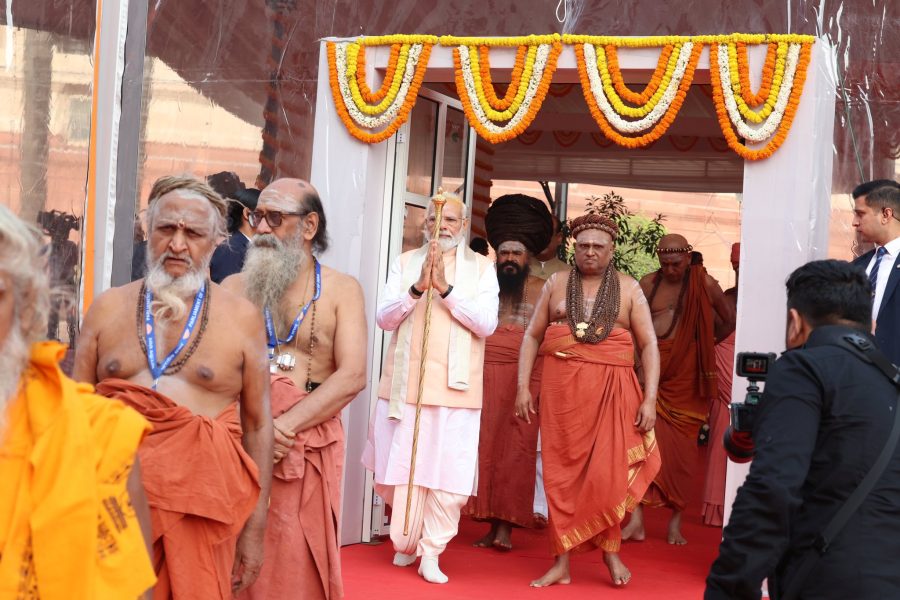
Is the 'august' Sengol a symbol of transfer of power? This is what experts in TN say

Even as the ‘august presence’ of the ‘Sengol’ was installed inside the new Parliament building in a grand, ceremonious spectacle in New Delhi on Sunday (May 28), in Tamil Nadu, political historians and a Saivite scholar have debunked the national ruling party’s claims that this gold coated silver sceptre, is a historic symbol of ‘the transfer of power’.
Though there is a lack of solid evidence to claim Lord Mountbatten passed the sceptre to India’s first Prime Minister Jawaharlal Nehru to symbolise the transfer of power from the British, the narrative built by the BJP around the sceptre has gone viral on and off social media. This sceptre, which had been housed in a museum in Allahabad all these years, has a new home and now has been imbued with a deep significance and linked to a Saivite holy order.
A token of love
In the midst of this ‘transfer of power’ narrative pushed by the BJP, which some believed is being done largely to win over the sentiments of Tamils, a DMK historian clarified that the Sengol in the south is largely used as a “gift’.
Dravidian party cadres, especially from the DMK, used to gift the silver or gold coated Sengol along with silver swords as gifts to regional satraps on their birthdays and to party leaders at state level conferences, said K Thirunavukkarasu, a veteran DMK historian.
“Dravidian leaders accepted gifts like flower thrones and sceptres as a token of people’s love. Dravidian leaders accepted these gifts to make their followers happy since the cadres used to be on cloud nine. It was a quick way to reach people’s hearts and also helped them in taking Dravidian ideologies to the grassroots,” he added.
Also read: New Parliament building reflects aspirations of New India: PM Modi at inauguration
The sceptre, the Sengol, was also viewed as the remnants of monarchy regimes, claimed Thirunavukkarasu. It may have been viewed as a symbol of the monarchy during the Chola times but the DMK patriarch M Karunanidhi once famously wrote that the Sengol (sceptre) can come and go but what always remains is the eludhukol (pen).
Sceptres inside memorial
The former Tamil Nadu Chief Minister and AIADMK founder, MG Ramachandran, too held a similar view about the sceptre. He saw it as a gift and even-handed a silver sceptre or the Sengol to his protegee J Jayalalithaa at a party conference held in Madurai. Though MGR and Jayalalithaa were reunited after few years of separation at this conference, MGR probably did not consider the gift as anything very significant.
Political analyst Tharasu Shyam believed that MGR viewed it as nothing more than a gift given with love. He received many such sceptres at party conferences and meetings and it held no particular meaning for him, as MGR wrote in his will that all the gifts, which included the Sengols, given to him should be housed in his memorial, said Shyam.
“The memorial built with MGR’s own money and land, has all the gifts, including the sceptres, he had received as a party leader. For MGR, the sceptres were mere gifts and he didn’t give much importance to them or revere them,” pointed out Shyam.
Also read: New Parliament inauguration: Sengol triggers BJP-Congress war of words
Saivite connection
A Saivite scholar scoffed at this ‘distorted’ view being perpetuated about the sceptre as a ‘transfer of power’ because of the common man’s scant understanding of the Sengol.
Chokkalingam, a Saivite scholar, said that in Saivism, ethics and justice are equivalent to god. “In ancient days, the king who ruled in an ethical way was seen as god. So, whenever there was a change of power like a prince inheriting the throne and becoming a king, the head priest of the king’s family used to gift a sceptre to the new incumbent. But, it need not be perceived as a symbol of transfer. It was an act to remind the newcomer to rule with ethics and dharma,” he said.
There is however a tradition among the Aadheenams (Saivite Mutts) to present gods with the Sengol on special religious occasions. In fact, the tradition of doing so is still continuing in the Madurai Meenakshi Amman temple and Tirunelveli Nellaiappar temple.
“There is a possibility Rajaji saw this tradition being followed in the temples and got an idea to connect Thiruvavaduthurai Aadheenam to hand over a sceptre to Nehru. It should be noted that the sceptre in focus today is the Nandi sceptre because the bullock is considered as a vehicle of Lord Shiva,” Chokkalingam pointed out.
Installing the Sengol next to the Parliament Speaker’s chair with traditional pomp with priests in attendance, has come at a time, amid the boycott of the function by the Opposition parties, which also includes the DMK. Political observers also felt it is a way for the BJP to woo people in the south who have turned their backs on them.
Even as people quibbled over the origins of the Sengol, the usage of the sceptre – an archaic tool of monarchy – in the times of democracy, has also raised eyebrows.


